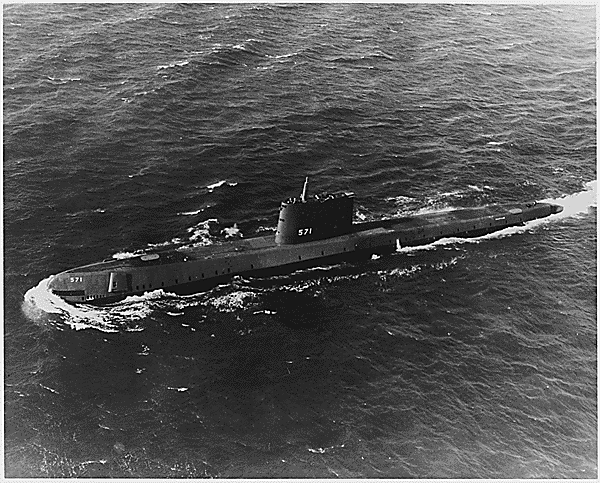On 30 September 1954 the USS Nautilus (SSN-571) was commissioned, with Commander Eugene P. Wilkinson taking command. It was the world's first operational nuclear submarine, capable of remaining submerged for far longer than diesel-fuelled vessels.
Below is an extract from New Vanguard 138: US Nuclear Sumbarines: The Fast Attack.
The USS Nautilus was a big submarine. It had three decks and plenty of internal space compared with the fleet submarine. Alongside its ability to stay completely submerged nearly indefinitely, it was fast. A Tench Class fleet submarine could run at 22 knots on the surface and a Tang Class diesel-electric could make 18 knots in a short burst or 11 knots snorkeling. Nautilus could make 23 knots while remaining completely submerged for months. It could evade destroyer screens, run in and attack escorted high-value targets, and run out again. The down-side of this speed was a very high noise level. Its ballast tank flood ports and its relatively thin plating made a humming sound that varied in frequency and intensity with speed. It has been said that the noise was so loud it prevented any conversation in the torpedo room expect by shouting. Nautilus had a BQR-4 passive sonar system. The 48 vertical stave hydrophones wrapped around just inside the skin of a sonar dome that was faired into the forefoot of the boat. This sonar system was useless at any appreciable speed because of the noise created by the ship itself. However, using sprint and wait tactics, Nautilus proved to be a dangerous adversary. During one of her first tactical trials she demonstrated a greater threat than all the accompanying diesel-electric submarines combined.

The USS Nautilus during initial sea trials, January 1955.
Nautilus had six torpedo tubes forward in the torpedo room. The crew and officers' berthing and messing spaces were located aft of the torpedo room. The control roomo and conning stations were father aft under her large sail (or "fin" in Royal Navy nomenclature). Just over half the ship was taken up by the reactor compartment and engine room. The reactor compartment housed the reactor, primary coolant piping, steam generators, and attendant systems. It was not a manned space and was only accessible if the reactor was shut down. Passage fore and aft took a place through a narrow shielded space at the top of the reactor compartment, which came to be called "the tunnel".

Profile of the USS Nautilus by Tony Bryan
With the steam plant came a few benefits not generally availble to diesel-electric boat sailors. The first was a large quantity of fresh water for cooking and personal use. Water for showers and bathing was very limited, if available at all, on diesel-electric subs. The second benefit was air conditioning. Having a steam plant in an enclosed space demanded some method of dealing with heat build-up, but a large amount of availble electricity allowed for major air-conditioning plants to be installed and operated. These increased the level of habitability to a point not seen on previous boats.
If this blog has piqued your interest be sure to pick up New Vanguard 138: US Nuclear Sumbarines: The Fast Attack by Jim Christley, with illustrations by Tony Bryan.

Comments
You must be logged in to comment on this post. Click here to log in.
Submit your comment